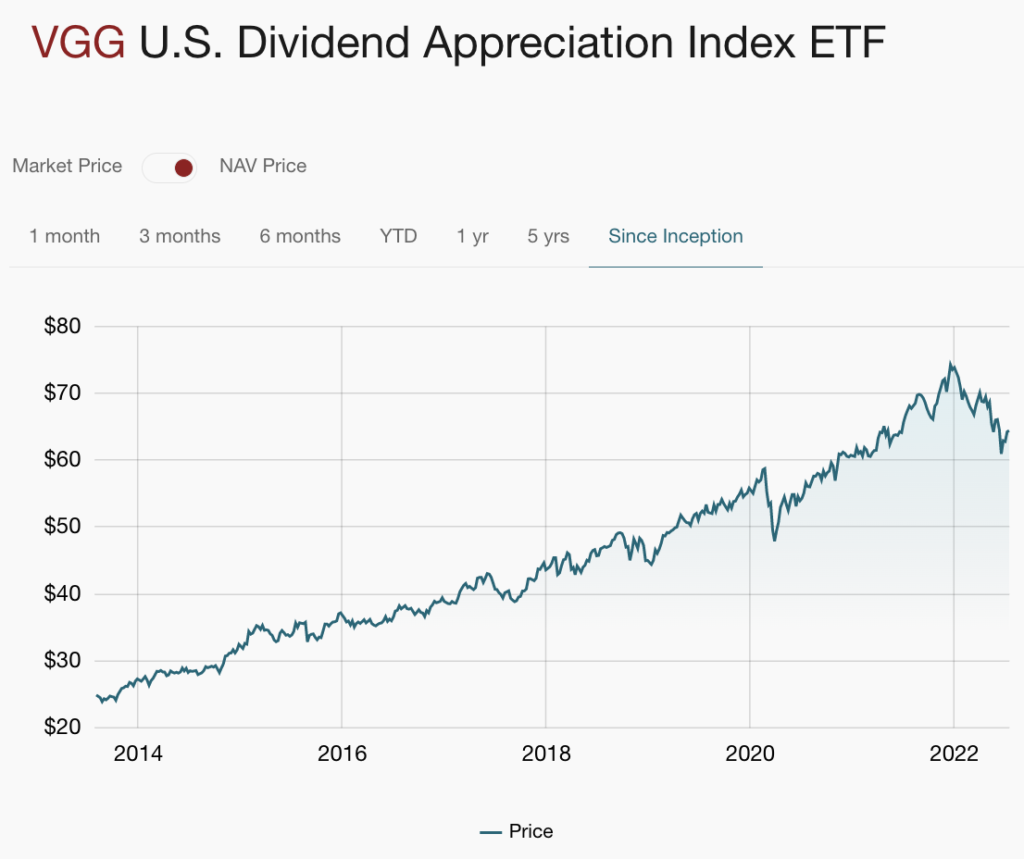Looking to invest in U.S dividends without having to pick your own stocks?
This Vanguard ETF might be the right choice for you to get easy access to this specific investment strategy.
Let’s go over this Vanguard VGG ETF review to see if it’s the right choice for you.
Medium Risk, Dividend Investment ETF
This product invests primarily in stocks of U.S.-based companies with a track record of improving dividend yields for investors.
- Investments across many sectors
- Adds us-based exposure to international investors
- Tax-efficient
- Easy to purchase
- Higher expense ratio than alternative products
What Is Vanguard VGG ETF?
VGG is a Canadian-based ETF product offered by Vanguard that pays quarterly dividends. This ETF is traded on the Toronto Stock Exchange. The fund was created in August 2013.
VGG is currently trading close to a price of $80.22.
VGG Key Facts
As of July 15, 2022:
- Ticker Symbol: VGG.TO
- Exchange: Toronto Stock Exchange
- Assets Under Management: $933.819 Million
- MER: 0.30%
- 12-Month Trailing Yield: 1.45%
- Currency Traded: CAD
- Eligible Accounts: Most registered (TFSA, RRSP, etc) and non-registered available
VGG MER
VGG has a management fee of 0.28% and an MER (management expense ratio) of 0.30%, making it slightly higher than some of the alternative ETF options out there.
VGG Dividends
Vanguard’s VGG’s dividend yield as of June 30, 2022:
- 12-month trailing yield: 1.45%
- Distribution yield: 1.41%
- Dividend schedule: Quarterly
VGG Performance
Since its inception in August of 2013, VGG has yielded an average return of 15.03% per year. Below you can see the average performance over time and notice that the ETF has kept up with its benchmark.

Showing 31 Aug 2013 – 30 Jun 2022:
| Fund Type | Month End | YTD | 1YR | 3YR | 5YR | Since Inception |
|---|---|---|---|---|---|---|
| VGG (Market Price) | −4.85% | −14.62% | −2.72% | +8.31% | +10.38% | + 12.57% |
| VGG (NAV) | −4.66% | −14.42% | −2.46% | +8.41% | +10.46% | + 12.60% |
| Benchmark | −4.40% | −14.01% | −2.09% | +8.53% | +10.54% | + 12.77% |
Go to the Vanguard website for real-time performance numbers of VGG.
What Does Vanguard VGG Invest In?
VGG looks to follow the NASDAQ U.S. Dividend Achievers Select Index by holding investments from large-capitalization companies that have a proven track record of increasing dividends over time.
Below you can see the breakdown of which sectors are currently being held within VGG.
VGG Vanguard Sector Weighting
When you invest in VGG, you’ll receive a nice weighted mix, including a majority in Industrials and Health Care. Take a look at the remaining sectors included in the fund below.
As of 30 Jun 2022:
| Sector | Fund |
|---|---|
| Industrials | 20.9% |
| Health Care | 15.9% |
| Financials | 14.8% |
| Technology | 13.0% |
| Consumer Discretionary | 12.8% |
| Consumer Staples | 11.0% |
| Utilities | 4.2% |
| Basic Materials | 3.8% |
| Telecommunications | 3.4% |
| Energy | 0.1% |
| Total | 100.0% |
VGG Portfolio Characteristics
As of 30 Jun 2022:
| Fundamentals | Fund |
|---|---|
| Number of Stocks | 289 |
| Median Market Cap | $186.7 B |
| Price / Earnings Ratio | 19.4 x |
| Price / Book Ratio | 4.0 x |
| Return on Equity | 24.2% |
| Earnings Growth Rate | 15.7% |
VGG Holdings
The top ten holdings will align with the sector weightings mentioned above. You’ll probably recognize all of the companies on the list, as the ETF is filled with a majority of large-capitalization companies.
It’s important to note that 100% of VGG is U.S.-based equity holdings.
As of 30 Jun 2022:
| Holding Name | % of Market Value | Sector |
|---|---|---|
| UnitedHealth Group Inc. | 4.18% | Health Care Management Services |
| Johnson & Johnson | 4.06% | Pharmaceuticals |
| Microsoft Corp. | 3.85% | Software |
| Procter & Gamble Co. | 3.02% | Personal Products |
| JPMorgan Chase & Co. | 2.87% | Diversified Financial Services |
| Visa Inc. Class A | 2.72% | Transaction Processing Services |
| Home Depot Inc. | 2.49% | Home Improvement Retailers |
| Mastercard Inc. Class A | 2.36% | Transaction Processing Services |
| Coca-Cola Co. | 2.13% | Soft Drinks |
| PepsiCo Inc. | 2.00% | Soft Drinks |
VGG Market Capitalization
As of 30 Jun 2022:
| Capitalization | Fund | Benchmark |
|---|---|---|
| Large | 76.33% | 76.30% |
| Medium/Large | 3.86% | 3.85% |
| Medium | 12.47% | 12.52% |
| Medium/Small | 4.41% | 4.40% |
| Small | 2.93% | 2.92% |
| Total | 100.00% | 99.99% |
VGG Market allocation
VGG is invested entirely in the US market.
As of 30 Jun 2022:
| Country | Region | Fund | Benchmark |
|---|---|---|---|
| United States of America | North America | 100.0% | 100.0% |
| Total | 100.0% | 100.0% |
VGG Risk And Volatility
As of June 30, 2022:
| Fund Type | R-Squared | BETA | ALPHA | Standard Deviation | Sharpe Ratio |
|---|---|---|---|---|---|
| Fund | 1.00 | 1.01 | − 0.01 | 12.47% | 0.63 |
| Benchmark | — | — | — | 12.39% | 0.64 |
Comparing Similar Vanguard Dividend ETFs

VGG vs VIG
In many respects, these two ETF funds are similar in that they are primarily poised as dividend funds. They both share the same benchmark, the NASDAQ US Dividend Achievers Select Index. Because of this, they both hold 100% U.S.-based equities.
The major differences are that VIG has an expense ratio of 0.06% and $71.3 billion in net assets. This makes it a larger, more affordable fund if you have this option available to you. However, you must be aware that if you invest as a Canadian, you’ll be incurring foreign exchange fees when investing in VIG.
VGG vs VGH
These two ETF funds are almost identical. The main difference is that VGH is CAD-Hedged.
A CAD-Hedged fund generally provides protection against currency fluctuations. That means your fund is held in CAD and less affected by currency fluctuations if the USD goes down.
VGG Alternatives and Competitors

FCUD vs VGG
Fidelity U.S. High Dividend Index Fund (FCUD) is an alternative investment offered by Fidelity that is similar to VGG. This fund is also targeting large and mid-cap U.S. equities that offer nice dividends. FCUD currently has an MER of 0.39%, $176.7 million net assets (as of July 20, 2022), and has monthly distributions.
The biggest difference between FCUD and VGG is their sector and company selections.
XHU vs VGG
iShares U.S. High Dividend Equity Index ETF (XHU) is offered by BlackRock. It is similar to VGG in that it’s a dividend index ETF. However, it only holds 75 companies. XHU currently has MER of 0.34%, $216 million in net assets (as of July 20, 2022), and has monthly distributions.
Who Should Buy VGG?
VGG appears to be an excellent choice for investors who want exposure to a U.S. equity ETF product with minimal volatility but do not mind the higher MER. Adding VGG as a medium-risk investment to your portfolio is expected to provide modest growth through dividends.
How To Buy Vanguard VGG ETF In Canada
My favourite and cheapest ways to buy ETFs in Canada are:
| Image | Product Title | Features | Price |
|---|---|---|---|
Editor's Choice  |
| Get $25 Signup Bonus | |
Reliable Pick  |
| Get $50 Free Stock Trades |
To learn more, check out my full breakdown of the best trading platforms in Canada here.
Our Final Verdict: Is VGG a Good Buy?
If you’re looking for an ETF that has a focus on dividends and is primarily composed of US holdings, then I recommend that VGG could be the product for you. The fund is diversified across many different sectors, which may help alleviate some volatility.
With a higher MER than alternatives available to investors interested in similar products, Vanguard U.S. Dividend Appreciation Index ETF might not offer as much value compared to other funds with lower fees or better performance since its inception date.
If your goal is simply providing exposure to dividend stocks within the United States without taking on too much risk (or letting the currency fluctuations impact your investments), then there are a few options better suited.
Check out these other dividend ETFs in Canada that you can try.





